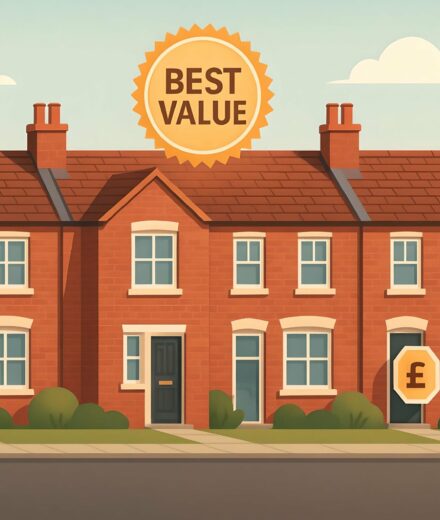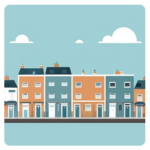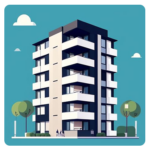

House Prices > Brighton
| Year | Average Price | Transactions |
|---|---|---|
| 2025 (proj.) | £442,200 | 3,069 |
| 2024 | £430,700 | 2,240 |
| 2023 | £428,600 | 2,448 |
| 2022 | £434,100 | 3,342 |
| 2021 | £415,200 | 4,403 |
| 2020 | £390,000 | 2,737 |
| 2019 | £369,200 | 3,077 |
| 2018 | £368,900 | 3,237 |
Ever wondered whether Brighton’s housing market is really climbing faster than a seagull after a bag of chips? Let’s break it down.
Since 2018, Brighton’s average house price has drifted upwards, with some years seeing bold leaps and others taking a slower stroll. The average sold price has nudged up each year apart from a minor stumble in 2023, before regaining pace in 2024 and heading for a projected record in 2025. That’s a story of resilience.
But what about transactions? The numbers have ebbed and flowed, peaking in 2021 before falling to their lowest in 2024—only to jump again in the forecast for 2025. The data suggests that while buyers have become more selective, pent-up demand still lives in the pebbled streets and leafy terraces of this city. When confidence returns, Brighton’s market springs back to life, as lively as North Laine on a Saturday morning.
So what’s the core message? Brighton’s property market has shown almost unstoppable energy, with only rare pauses along the way. Prices are up, the city remains hotly contested, and the outlook suggests continued strength. If you’re wondering when to make your move, the signs say buyers are still facing tough competition for a slice of the city’s charm.
Got your heart set on Brighton? Start browsing through available houses in Brighton for sale.

Avg. Property Price: £625,000
Avg. Size of Property
1,350 sq/ft
Avg. Cost Per Sq/ft
£496 sq/ft
Total transactions
539 (since 2021)

Avg. Property Price: £480,000
Avg. Size of Property
1,050 sq/ft
Avg. Cost Per Sq/ft
£471 sq/ft
Total transactions
1,239 (since 2021)

Avg. Property Price: £433,400
Avg. Size of Property
876 sq/ft
Avg. Cost Per Sq/ft
£508 sq/ft
Total transactions
4,564 (since 2021)

Avg. Property Price: £314,600
Avg. Size of Property
684 sq/ft
Avg. Cost Per Sq/ft
£475 sq/ft
Total transactions
803 (since 2021)
Brighton’s property market is nothing short of eclectic, offering a striking array of living experiences that cater for every lifestyle under the sun. Whether you crave a slice of coastal tranquillity in a detached home, or the pulse of city living in a characterful flat, Brighton’s diversity isn’t just on its seafront but stitched into its housing stock.
What stands out brightest is just how distinct property types shape the buying experience for different households. Detached homes are the undisputed titans of space and privacy, boasting garden plots and square footage that let you host garden parties or simply unwind in peace after a long promenade at the pier. Their larger average size makes them a magnet for families seeking room to grow, though that privilege does command a premium.
Then again, Brighton’s terraced houses and semi-detached homes draw the biggest crowds, with a noticeable volume of transactions since 2021. That level of demand suggests these homes are striking a gorgeous balance between aspiration and practicality. You can almost picture leafy, pink-blossomed streets filled with neighbours catching up at the gate — the sort of scene you get in picture-perfect postcards. Terraced homes, in particular, seem to thrive in the heart of Brighton’s most sociable, walkable areas, offering buyers the right blend of character and convenience.
For those in search of vibrancy, flats in Brighton unlock prime urban locations and contemporary comfort without the soaring price tags of family homes. With a slightly higher average cost per square foot than semis, every inch has to work hard – think clever layouts, period features, or the irresistible lure of a Regency balcony. Their popularity among younger professionals, downsizers and city explorers is reflected in the lively turnover of flats sold – proof that Brighton’s heart beats loudest in its apartments.
The variation in average property prices and cost per square foot isn’t just academic. It shows how much location, home type and lifestyle choices matter here. For the budget-conscious or strategic, there are still artful ways to play the market. Check these Brighton districts if you’re looking to save – sometimes, the best value hides on the side streets rather than the main avenues.
| District | Avg Price (£) | Transactions |
|---|---|---|
| BN1 | £425,600 | 9,098 |
| BN2 | £398,400 | 9,384 |
| BN41 | £346,100 | 2,105 |
| BN42 | £388,500 | 1,011 |
| BN45 | £588,700 | 60 |
Brighton’s patchwork of districts turns the usual property map on its head. The numbers tell a sprawling, almost unpredictable story. In some neighbourhoods, prices soar on sea-breeze demand, whilst others offer quieter, more accessible entry points. Transaction counts aren’t always paired with the highest prices, making us question the conventional wisdom of “pay more for more demand”. Is Brighton simply bucking tradition, or are deeper trends swirling beneath the surface?
For those priced out of city-centre streets, the outskirts often act as a calm harbour, quietly gathering pace. Suburban districts in Brighton display more modest average values, but their rhythm is anything but subdued. Transaction volume pulses strongly in areas where first-timers and families feel welcome. It’s not all glitz and gold-plated pavements. Buyer activity, in several districts, is moving faster than the 5A bus through Hove on a Saturday morning.
Yet, luxury pockets stand almost in a world of their own. Certain postcodes in the north, close to the Downs, now see average prices that eclipse anything coastal or central. Is this a sign of the rising suburban premium, or just a blip caused by rare properties changing hands? The relative scarcity in transaction counts there leaves us with an unanswered question. Are we seeing a true uptrend in desirability, or a distortion driven by unusually large or unique sales?
At M0VE, we’ve noticed that buyers consistently hunt for the sweet spot: the elusive mix of affordability, lifestyle and future promise. You might wonder, where does your district fit in? Exploring price patterns for your specific neighbourhood could reveal surprising value or hidden drawbacks. We’ve broken down key trends in our Brighton Property Valuation Explained: How Much Could You Sell For? guide.
Ultimately, Brighton’s district-level figures remind us: every property story here is uniquely local, and sometimes the best value sits just beyond the obvious hotspots.
Please also check out the following areas in Brighton for further insights:
| City | Avg Price (£) | Transactions |
|---|---|---|
| Hove | £440,800 | 7,083 |
| Shoreham-By-Sea | £417,100 | 2,197 |
| Hassocks | £489,200 | 1,624 |
| Peacehaven | £324,500 | 2,011 |
| Lewes | £479,500 | 2,508 |
| Lancing | £322,900 | 2,377 |
| Burgess Hill | £382,300 | 3,866 |
| Newhaven | £279,000 | 1,201 |
| Steyning | £440,600 | 701 |
| Henfield | £483,600 | 718 |
Brighton’s property market stands apart from its neighbours, and for many locals, it’s a point of fierce pride. Just look at neighbouring towns: some have steeper prices, others tempt with gentle seaside affordability, but none quite capture Brighton’s unique blend of atmosphere, creativity, and that infectious buzz you only find on this stretch of the south coast.
The thing that jumps out? Brighton is both desirable and dynamic. Despite steady demand and prices that rival London’s outer limits, the town still manages a higher ebb and flow of home-buyers than most spots nearby. Our housing supply tightens up regularly, almost as congested as a Friday crowd on Western Road, which keeps prices stable and appetite strong.
Picture Brighton’s market like a bonfire on the beach: inviting, reliably busy, and always burning bright. If you want somewhere crackling with energy and colourful local spirit, you’d be hard-pressed to beat our corner of Sussex.
Please keep in mind, these comparisons focus strictly on property sale averages and transaction totals.
Property size and cost per square foot are not factored in, meaning some shifts may be missed. To explore further, visit our blog.
We blend refined, credible datasets from official sources with our deeply intelligent valuation engine to produce strikingly precise estimates for every single UK street. Through intricate recalibration of raw EPC and Land Registry figures (removing distortion along the way), we unlock unusual clarity.
Our site uses cookies. By using this site, you agree to the Privacy Policy and Terms of Use.